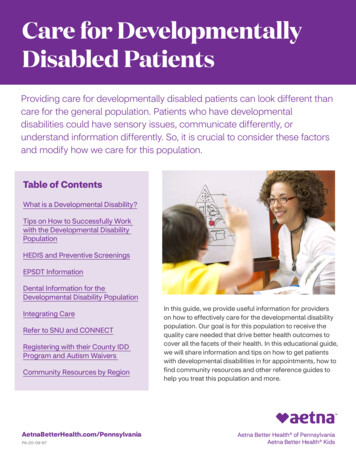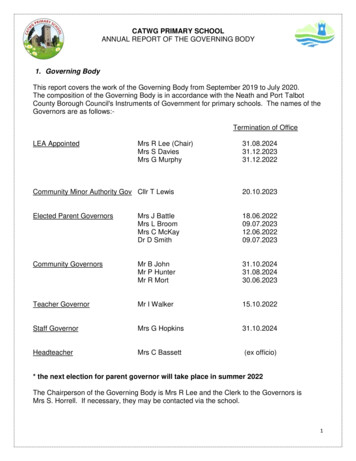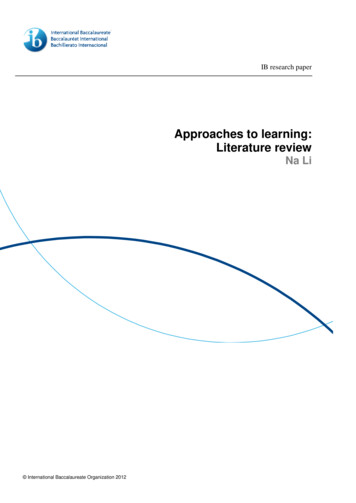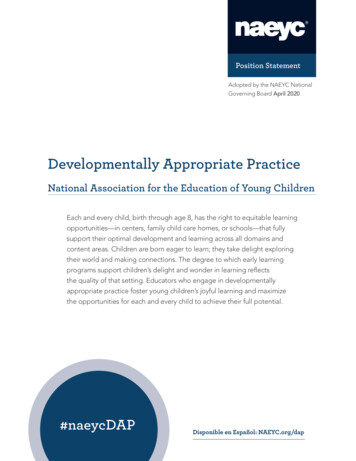
Transcription
Care for DevelopmentallyDisabled PatientsProviding care for developmentally disabled patients can look different thancare for the general population. Patients who have developmentaldisabilities could have sensory issues, communicate differently, orunderstand information differently. So, it is crucial to consider these factorsand modify how we care for this population.Table of ContentsWhat is a Developmental Disability?Tips on How to Successfully Workwith the Developmental DisabilityPopulationHEDIS and Preventive ScreeningsEPSDT InformationDental Information for theDevelopmental Disability PopulationIntegrating CareRefer to SNU and CONNECTRegistering with their County IDDProgram and Autism WaiversCommunity Resources by 7In this guide, we provide useful information for providerson how to effectively care for the developmental disabilitypopulation. Our goal is for this population to receive thequality care needed that drive better health outcomes tocover all the facets of their health. In this educational guide,we will share information and tips on how to get patientswith developmental disabilities in for appointments, how tofind community resources and other reference guides tohelp you treat this population and more.Aetna Better Health of PennsylvaniaAetna Better Health Kids
What is a Developmental Disability?Developmental Disabilities is a broad term that includesa range of disabilities that fall into four main categories: Sensory related disabilities Nervous system disabilities Metabolic disabilities Degenerative disordersDevelopmental disabilities cause limitations in function specifically affecting an individual’s mental andphysical health while also causing impairment in physical, learning, language, or behavior areas.Developmental disabilities can impact persons of all ages, but they are usually diagnosed before theage of 22. They impact a person’s day to day functioning, and usually lasts throughout their lifetime.Specific Developmental Disability ConditionsAttention-Deficit Disorder (ADD): ADD is considered a common neurodevelopmental disorder forchildren and typically continues into adulthood. Children with ADHD have difficulty paying attention, canbe impulsive, and may be hyperactive.Autism Spectrum Disorder (ASD): ASD is a disability that causes the child or adult to experiencechallenges in social, behavioral, and communication areas. Persons with ASD can range from gifted toseverely challenged.Cerebral Palsy (CP): CP is disorder that affects a person physically, specifically impacting their ability tomove and sustain balance and posture. It is considered the most common disability in childhood.Fetal Alcohol Spectrum Disorders (FASDs): FASDs are conditions that are caused by mothers who drinkalcohol during pregnancy. They can be prevented if a mother does not drink alcohol while pregnant.Intellectual Disability: Intellectual Disabilities cause impairments to a person’s ability to learn and functionat an expected level. It may take longer for children with Intellectual Disabilities to learn, speak, walk, dress,or eat without help.Muscular Dystrophy: Muscular Dystrophy is considered a muscle disease that is caused by genemutations. This disability causes impairments in a person’s mobility and muscle weakness.Other conditions include: Fragile X Syndrome, Hearing Loss, Kernicterus, Language and SpeechDisorders, Learning Disorders, Tourette Syndrome, and Vision Impairment.For more information about specific Developmental Disability conditions, please visit CDC.gov.Care for Developmentally Disabled Patients2Aetna Better Health of PennsylvaniaAetna Better Health Kids
General Tips to Work with This PopulationA developmental disability can affect physical, cognitive, learning, language and behavioraldevelopment. This has an impact on how a person grows and functions. These disabilities mayimpact a person’s ability to perform in school, work, and in social settings.Keep these helpful tips in mind:- Not all disabilities are visible- Some people have temporary disabilities- A person’s wheelchair is a part of his or herpersonal space- Be an active listener with those who havedifficulty speaking- Use a calm and reassuring voice with shortand simple, concrete words for communicating- Pay attention to both verbal and nonverbalcommunications- Acknowledge that the person’s feelings areunderstandable- Emphasize what the person can do The person may have trouble performing activities of daily living (ADLs) independently such as bathing,dressing, toileting, or feeding themselves. If their physical functioning is impaired, the person may have trouble using their muscles and unable tocontrol muscle movements. This would impair their ability to move from one place to another. The person may have trouble communicating with others or has difficulty understanding the speech ofothers, writing, or reading. Communication difficulties may include the ability to understand socialsituations. They may have trouble understanding social cues and nonverbal communication. The person may have difficulty performing in a work setting which would affect their ability to supportthemselves independently. They may need to rely on others to care for them. They may feel the inabilityto make choices for themselves and to control the direction of their own lives. The person may have trouble coping with stressors. They may feel angry, frustrated, resentful,depressed, hopeless, guilty, and even embarrassed. They may have a hard time expressing their needs,wants, and feelings to others.Care for Developmentally Disabled Patients3Aetna Better Health of PennsylvaniaAetna Better Health Kids
HEDIS Measures and Preventive CareWeight Assessment and Counseling for Nutrition andPhysical Activity for Children/Adolescents (WCC)HEDIS Measurement Year 2020 & 2021 MeasuresMeasure Description: The percentage of members 3–17 years of age who had an outpatient visitwith a PCP or Ob/Gyn and who had evidence of the following during the measurement year. BMI percentile documentation* Counseling for nutrition Counseling for physical activity*Because BMI norms for youth vary with age and gender, this measure evaluates whether BMIpercentile is assessed rather than an absolute BMI value.DefinitionsBMI percentile: The percentile ranking based on theCDC’s BMI-for-age growth charts, which indicatesthe relative position of the patient’s BMI numberamong others of the same gender and age.Strategies for Improvement Utilize NCQA coding tips to actively reflect carerendered. Document BMI percentile, discussion of nutritionand physical activity during at least one officevisit annually e.g. sick visit or well-child exam. Document all screenings in the medical record,including follow-ups, results and anticipatoryguidance given.The following are just a few of the approvedcodes. For a complete list please refer to theNCQA website at NCQA.org.BMI Percentile ICD-10 CodesZ68.51Less than 5th percentile for ageZ68.525th percentile to less than 85th percentile for ageZ68.5385th percentile to less than 95th percentile for ageZ68.54Greater than or equal to 95th percentile for ageNutrition CounselingICD-10Z71.3Dietary counseling and surveillanceCPT97802-97804Nutrition counselingHCPCSS9470Nutritional counseling, dietitian visitHCPCSG0447Face-to-face behavioralfor obesity, 15 minutescounselingPhysical Activity CounselingDocumentation RequirementsFor documentation in the medical record refer tothe following table to identify what meets criteria:Numerator CodesThere is a large list of approved NCQA codes usedto identify the services included in the WCCmeasure.ICD-10Z02.5Encounter for examination forparticipation in sportICD-10Z71.82Exercise counselingHCPCSG0447Face-to-face behavioral counselingfor obesity, 15 minutesHCPCSS9451Exercise classes, non-physicianprovider, per session**Please note: The WCC measure is hybrid. Anycare missed via claims during the measurementyear will result in medical record requests in theHEDIS Medical Record Review Project.Quality Measure 31 (rev 09/20)Aetna Better Health of Pennsylvania Aetna Better Health KidsHEDIS is data used to measure the timeliness and effectiveness of caremembers are receiving. This includes access to care, utilization of care, andmembers’ satisfaction with care. It is a Pennsylvania state requirement, andthe requirements are followed by NCQA guidelines. HEDIS also evaluatesperformance in key areas such as quality of care, access to care,satisfaction with the care members receive and provides a clear picture ofthe outcomes of care members receive in specific areas.While the Developmental Disability population is complex, monitoring andmeasuring care delivered is important and must be done for theDevelopmental Disability population to achieve better health outcomes.Monitoring HEDIS scores is an effective way of helping people withDevelopmental Disabilities close gaps in care and assist them in gettingthe necessary preventive care that are needed for early detection. Earlyintervention can help lead to positive health outcomes.HEDIS Measures That Encompass Preventive Care Well-Child Visits include health history, physical developmental history, mental development history,physical exam, and health education or anticipatory guidance.- W30 (Well-Child Visits in the first 30 months of life) includes children 15 months of age with six ormore visits with their PCP and also includes children 30 months with two or more visits in the last 15months.- WCV (Child and Adolescent Well-Care Visits) includes the percentage of members ages 3-21 yearsof age who ha at least one comprehensive well-care visit during the measurement year. WCC (Weight Assessment and Counseling for Children) include members 3-17 years of age who hadan outpatient visit with a PCP or OB/GYN and have evidence of all three components in the measurementyear. The three components are BMI percentile documentation, Counseling for nutrition, and Counselingfor physical activity. ABA (Adult BMI Assessment) includes member 18-74 years of age who had an outpatient visit andwhose body mass index BMI was documented during the measurement year or the prior year. ADV (Annual Dental Visit) include members 2-20 years of age who had at least one dental visit duringthe measurement year. TOPC (Timeliness of Prenatal Care) includes the percentage of deliveries during the measurement yearthat received a prenatal visit in the first trimester on or before the enrollment start date or within 42 daysof enrollment in the organization. The measurement year for this measure is October 8th of the previousyear to October 7th of the current year. PPC (Postpartum Care) includes the percentage of deliveries between the measurement year (October8th of the previous year to October 7th of the current year) that completed a postpartum visit on orbetween 7 to 84 days after delivery.Care for Developmentally Disabled Patients4Aetna Better Health of PennsylvaniaAetna Better Health Kids
CCS (Cervical Cancer Screening) Includes women 21-64 years of age who were screened for cervicalcancer. BCS (Breast Cancer Screening) includes women 52 to 74 years of age who had a mammogram toscreen for breast cancer. CIS (Child Immunization Status) includes children 2 years of age who had four diphtheria, tetanus, andacellular pertussis (DTaP); three polio (IPV); one measles, mumps and rubella (MMR); three haemophilusinfluenza type B (HiB); three hepatitis B (HepB), one chicken pox (VZV); four pneumococcal conjugate(PCV); one hepatitis A (HepA); two or three rotavirus (RV); and two influenza (flu) vaccines by their secondbirthday. IMA (Immunizations for Adolescents) includes adolescents 13 years of age who had one dose ofmeningococcal vaccine, one tetanus, diphtheria toxoids and acellular pertussis (Tdap) vaccine, and havecompleted the human papillomavirus (HPV) vaccine by their 13th birthday. LCS (Lead Screening in Children) includes children 2 years of age who had one or more capillary orvenous lead blood test for lead poisoning on or before their second birthday.How to Prepare Your Patients for Preventive Care Services Build a relationship with the patient and the caregivers Explain to the caregiver about how important it is for them to be familiar and reliable with the patient’shealth Ask the caregiver to bring a comforting object from home so it alleviates an anxiety for the patient Check for any accommodations that the patient might need. (i.e., make sure to accommodate patient’swith sensory issues) If a patient is anxious to visit with the doctor, have them come in a few times before the appointment,without any examinations or treatments, so they get acclimated and feel comfortable in the office Respect the patient’s limits. If they are unable to finish the visit, they may need to come back again Prepare office staff for when a new patient with DD will be arriving Attempt to schedule the visit time so there is minimal waiting time Create an agenda at the beginning of the visit with the patient and caregiver present If an exam, immunization, etc., are needed, ask permission to proceed before any intrusion of thepatient’s personal space Explain and warn the patient about what to expect next (i.e., if a procedure needs to be performedimmediately, inform the patient) Always provide reassurance to the patient and caregiverCare for Developmentally Disabled Patients5Aetna Better Health of PennsylvaniaAetna Better Health Kids
EPSDT/Bright Futures OverviewEPSDT/Bright Futures Codes & AssessmentsNewborn(Inpatient)REQUIRED ASSESSMENTS/REQUIRED CODESNew Patient99460/99463Established PatientEarly and Periodic Screening, Diagnostic and Treatment isthe child health component of Medicaid. Children underage 21 who are enrolled in Medicaid are entitled to EPSDT/Bright Futures benefits. These benefits cover preventiveand treatment services.EPSDT/Bright Futures helps to ensure that children andadolescents receive all appropriate preventive, dental,mental health, and developmental services. These servicesare based on the Bright Futures periodicity schedule. Early: Assess and identify any problems early. Periodic: Children’s health is examined at periodic,age-appropriate intervals. Screening: Provide physical, mental, developmental,dental, hearing, vision, and other screening tests todetect any potential problems. Diagnostic: Perform diagnostic tests to follow upwhen a risk is identified.Aetna Bettert Healthlt off Pennsylvanias liAetna Bettert Healthlt KidsBy 12–3Month ars12–17Years18–20Years99381 NP 99381 NP 99381 NP99381 NP99381 NP99381 NP99382 NP99382 NP99382 NP99382 NP99382 NP99382 NP99382 NP99383 NP99384 NP99385 NP99391 EP 99391 EP99391 EP99391 EP99391 EP99392 EP99392 EP99392 EP99392 EP99392 EP99392 EP99392 EP99393 EP99394 EP99395 EP9255192551 (once between92551 (oncebetween ages 18–20)9255292552 (once between92552 (oncebetween ages 18–20)3–5Days99391 EPABOVE CPT CODE PLUSNewborn Metabolic Hemoglobin Screening Critical Congenital Heart Defect ScreeningNewborn BilirubinHearing (If initial hearing screening not completed in the hospital, (Screening should take place between newborn and 2 months of age.)screening should occur by 3 months of age.) Audio Screen (Perform assessment unless age of screening is indicated.)Assessed through observation or through health history/physical.92551 Pure Tone-Air Only (Perform assessment unless age of screening is indicated.)92552Vision (Perform assessment unless age of screening is indicated.)Vision Acuity ScreeningInstrument-Based ScreeningAssessed through observation or through health history/physical.Maternal Depression ScreeningAnemia (Initial hemoglobin or hematocrit between 9–12 months of age.) Hematocrit HemoglobinStructured Developmental ScreeningStructured Autism s 5, 6, 8, 10)(ages 5, 6, 8, 10)99173(ages 5, 6, 8, 10)ages 11–14 & 15–17)ages 11–14, 15–17)99173 (ages 12, 15)99174, 9917799174, 99177(ages 5, 6, 8, 10)(ages 12, 15)96161Risk AssessmentOnly85013850138501885018Perform screening if indicated by risk assessment and/or symptoms.9611096110RiskRiskYD (Box 10d)Assessment Assessment or Assessment Oral health risk assessment, referral to a dental home, at eruption of first tooth.9917399174,99177 Fluoride varnish (May be applied up to 4 times per year in PCP office,ages 0-16 Medicaid, CHIP – No age restriction.)9918899188991889918896110Perform screening if indicated by riskassessment and/or symptoms.96110 U196110 U1YD (Box 10d)or AssessmentYD (Box 10d)or AssessmentYD (Box 10d)or AssessmentYD (Box 10d)YD (Box 10d)YD (Box 10d)991889918899188991889918899188 (age 5)YD (Box 10d)YD (Box 10d)Risk assessment to be performed with appropriate action to follow if positive. Fluoride SupplementationVenous Lead (Blood lead test only. Up to, and including, age 6 if not previously done.)Dyslipidemia Screening836558365580061 (oncebetween ages 9–11)Perform screening if indicated by risk assessment and/or symptoms.Screening for Depression80061 (oncebetween ages 17–20)96160REQUIRED ASSESSMENTSDevelopmental SurveillancePsychosocial/Behavioral AssessmentTobacco, Alcohol or Drug Use AssessmentHealth & Developmental History (Physical & Mental)Height & WeightBMI ValueBMI Percentile or BMI Plotted on Age/Growth ChartHead CircumferencePhysical ExamPhysical Exam for Blood PressureHIV Screening (Those at increased risk of HIV infection should be tested Age 1196127 96160 96127 Z68.1-Z68.45 Risk Assessment to be performed with appropriate action to follow if .51-Z68.54 for HIV & reassessed annually.)Dyslipidemia AssessmentZ68.51-Z68.54Z68.51-Z68.54 Assessmentage 11(Assessment ages 12, 13, 14)Ages 6, 8 Ages 15, 16 or 17 Age 18(if not performed)ASSESSMENTS INDICATED VIA HISTORY OR SYMPTOMSTuberculin TestSickle CellSexually Transmitted InfectionsAs indicated via history or symptoms.REQUIRED PREVENTIVE COUNSELING & CODESAssessment & Counseling for NutritionAssessment & Counseling for Physical ActivityHealth Education/Anticipatory Guidance 71.82 REFERRAL CODES (BOX 10D OF CMS 1500)YD-Dental ReferralYM-Medical ReferralYV-Vision ReferralYH-Hearing ReferralYB - Behavioral Health ReferralYO-Other ReferralAny developmental problem found during a screening exam in a child under 5 years old should be referred through PA Connect: 1-800-692-7288for an appropriate referral to local, early intervention services.PA-18-02-36 (rev 07/20)In Pennsylvania, all children under the ageof 5 years old with a suspecteddevelopmental delay must be referred toCONNECT for Early Intervention Services.Providers may call the toll-free number at1-800-692-7288. Treatment: Treat any health problems found. Health careservices must be available for any screenings indicating a potential problem.There are a total of five components to an EPSDT exam. The screening services must include: A comprehensive health and developmental history (this include assessing physical and mental health) An unclothed physical examination Appropriate immunizations – Recommended by the Advisory Committee on Immunization Practices andapproved by the Centers for Disease Control and Prevention and the American Academy of Pediatrics Laboratory tests (for example a lead screening) Health education including anticipatory guidance about child developmentIn 2006, the AAP introduced guidelines to improve the early identification of developmental delay. Theguidelines are:1. Developmental surveillance should be performed at every visit- Surveillance is the process of recognizing children who may be at risk for developmental delays- Collects parental and clinician observations.- Tracks developmental milestones of the child over time.2. Periodic, routine formal screenings- Focus on all domains of development. Include administering standardized validated screening tools at9, 18, and 30 months and screening for autism at 18 and 24 months.3. Further testing or referral for evaluation for concerning screens or surveillance.Care for Developmentally Disabled Patients6Aetna Better Health of PennsylvaniaAetna Better Health Kids
Dental Information for Developmental DisabilitiesPopulation (Medicaid)Pennsylvania Performance MeasureHaving access to routine oral healthcare that includes services such as a dental cleaning can ensure a healthymouth for your patients and our members. Oral healthcare helps patients avoid cavities, gum disease, andwearing of their teeth’s enamel. Aetna Better Health measures oral health care for patients with developmentaldisabilities through the Pennsylvania Performance Measure (PAPM) - Annual Dental Visits for members withDevelopmental Disabilities (PAPM ADD). This measure assesses the percentage of Medicaid enrollees with adevelopmental disability age 2 through 20 years of age, that had at least one dental visit during themeasurement year. Please see the attached flyer for more information surrounding the PAPM ADD Measure.ReferralsIf you have a patient with special needs, we can assist you in finding a dentist who specializes in care forthese children. Contact SKYGEN USA Customer Service at 1-800-508-4892 for assistance in locating adental provider in your area that can assist the member in meeting their oral health needs. You can alsouse the Dental Provider Search.If using the online search tool, be sure to click on the green “Details” button to the right of each provider’sname to check the “Special Needs” status.Care for Developmentally Disabled Patients7Aetna Better Health of PennsylvaniaAetna Better Health Kids
Barriers to CareUnderstanding barriers to access is essential to ensuring that members receive appropriate care includingregular preventive services. We find that although most parents understand the importance of preventivecare, many confront seemingly insurmountable barriers to readily comply with preventive care guidelines.Examples of barriers to preventive care that we have encountered include: cultural or linguistic issues, lackof perceived need if children are not sick, lack of understanding of the benefits of preventive services,competing health-related issues or other family/work priorities, lack of transportation, difficulties withscheduling and other access issues. We work with providers to routinely link members with servicesdesigned to enhance access to preventive services, including: facilitating interpreter services, locating aprovider who speaks a particular language, arranging transportation to medical appointments, and linkingmembers with other needed community-based support services. Call Provider Services at1-866-638-1232 for help arranging any of these services.Strategies for SuccessSome strategies for a successful appointment and improving oral health outcomes for members withdevelopmental disabilities include: Determining each patient’s mental capabilities and communicationskills, involving caregivers in treatment plans, educating in language that patients can understand,repeating instructions as needed, and involving your patients in hands-on demonstration on good oralhealthcare habits such as brushing or flossing. In addition, providers can ensure physical comfort duringthe dental visit, keep appointments short, encourage plenty of water intake and offer the right oral healthcare tools that your patient and/or caregiver can use.Dental Oral Healthcare TipsHomecare plays a pivotal role in oral health, and we can implement strategies to assist the developmentaldisabilities population (and their caregivers). Be sure to work with members and caregivers to augment oralhealth care tools such as a toothbrush or floss.Adapting a toothbrush and making it easier to hold for patients, is certainly important. Electrictoothbrushes are an extremely efficient and effective tool in dental homecare. There is a wide range ofelectric toothbrush offerings on the market, and options to fit nearly every budget. Floss picks orinterdental brushes can also be used as flossing aides if a member or caregiver is unable to use thetraditional material and technique.If members are unable to brush and floss their own teeth, caregivers should be involved in an oral hygieneroutine. If unable to brush after meals, members and/or their caregivers can use disposable applicatorswabs to remove residual food in the mouth, around the teeth. Mouth rinses (especially those that containfluoride) are beneficial for members of all populations and should be used according to productinstructions.Learn about our Oral Health Performance Measures for dentists here.Care for Developmentally Disabled Patients8Aetna Better Health of PennsylvaniaAetna Better Health Kids
Integrating CareMembers who have Developmental Disabilities could be affected by other chronic medical illnesses andconditions, which could require multiple providers in multiple settings. Quality of care for the individual willimprove if all the providers, from multiple care settings, are working as a team. Integrating care deliversexpertise from multiple providers in areas, such as mental health, physical health, and substance use.Integration can also decrease the cost of healthcare delivery. Overall, integrated care creates better healthoutcomes for the patient and improves member and provider experiences.Before integrating care, providers should be aware of all Privacy rules, such as the Health InsurancePortability and Accountability Act (HIPAA), the Privacy Rule, and practice Protecting Patient’s HealthInformation (PHI). Once the patient gives the okay, and signs a consent form, the provider may begincoordinating care.The provider may give the “Treating the whole person, body and mind” card to the patient or caregiver toassist them with understanding the importance of care coordination. On the next page, there will be aWhole Person Flyer that keeps track of all the providers that are involved in the patient’s care process. Thepatient or caregiver can fill out their doctor’s contact information and address and keep it in a safe placewhere it can be easily accessible.Care for Developmentally Disabled Patients9Aetna Better Health of PennsylvaniaAetna Better Health Kids
Treating thewhole person,body and mindUnderstanding all your health needsYou can be a healthier, happier person when yourdoctors look at your health from both physicaland mental viewpoints.Physical health means your entire bodyincluding dental care.Mental health means your emotional andspiritual well-being and the conditionswhere you live, learn, work and play.Asking your doctors to shareyour health informationThere are strict rules to protect your privacy.These rules may keep your physical healthinformation separate from your mental healthinformation.Each of your doctors can work together to treatyou as a whole person if you ask them to shareinformation about your treatment.Your doctors can consider all of your health goalswhen you ask them to share your information.Your privacy would still be protected.Bring this card to your next visitTalk to your doctor about all your health careproviders working together as a team.Make the choice to be treated as a whole person.Member Services: 1-866-638-1232(TTY PA Relay: 711)Make a list of all of the health careproviders you ssNamePhone3x4AddressAetna complies with applicable Federal civil rightslaws and does not discriminate on the basis ofrace, color, national origin, age, disability, creed,religious affiliation, ancestry, sex gender, genderidentity or expression, or sexual orientation.ATTENTION: If you speak alanguage other than English,language assistance services,free of charge, are available toyou. Call 1-800-385-4104 (PARelay: 711).ATENCIÓN: Si usted habla español, los serviciosde ayuda de idioma, sin ningún costo, estándisponibles para usted. Llamar al1-800-385-4104 (PA Relay: 711).ВНИМАНИЕ: Если Вы говорите на русскомязыке, Вам предлагаются бесплатныепереводческие услуги. Позвоните по номеру1-800-385-4104 (PA Relay: 711).Disclosure# PA-17-10-09PA-18-01-36 (rev 122019)Care for Developmentally Disabled Patients10Aetna Better Health of PennsylvaniaAetna Better Health Kids
The Special Needs Unit and Case Management ServicesWhat Is the Special Needs Unit?The Special Needs Unit (SNU) is a separate unit within the Case Management Department designed toassist members with access to care, coordination of care, and connection with community resources.Special Needs Unit staff act as internal advocates for Aetna Better Health members and assist membersdirectly through our Special Needs Unit hotline and case management services.Who May Benefit from Special Needs Unit Support?Need help? Just call usThe Special Needs Unit is open to ALL membersregardless ofIf you think you have special health careneedsneed someonediagnosis or medical condition. “Special need”is anda broadandto help, just callus. Ask for someone in the Special Needsnon-categorical term which applies to any memberUnit. We’re whohere to mayhelp! benefitAetnaBetterHealthfrom additional support with gaining access to medical services or withSpecial Needs Unitmanaging their care. In some cases, support may be short-term, such1-855-346-9828as a single call to assist a member with locatinga communityresource.(PA Relay:711)AetnacomplieswithapplicableFederalrights lawsIn other circumstances, support needs may belonger-term and civilincludeand does not discriminate on the basis of race, color,case management services.ancestry, sex gender, gender identity or expression, orsexual orientati
What is a Developmental Disability? Tips on How to Successfully Work with the Developmental Disability Population. HEDIS and Preventive Screenings . EPSDT Information . Dental Information for the Developmental Disability Population. Integrating Care . Refer to SNU and CONNECT . Registering with their County IDD Program and Autism Waivers










